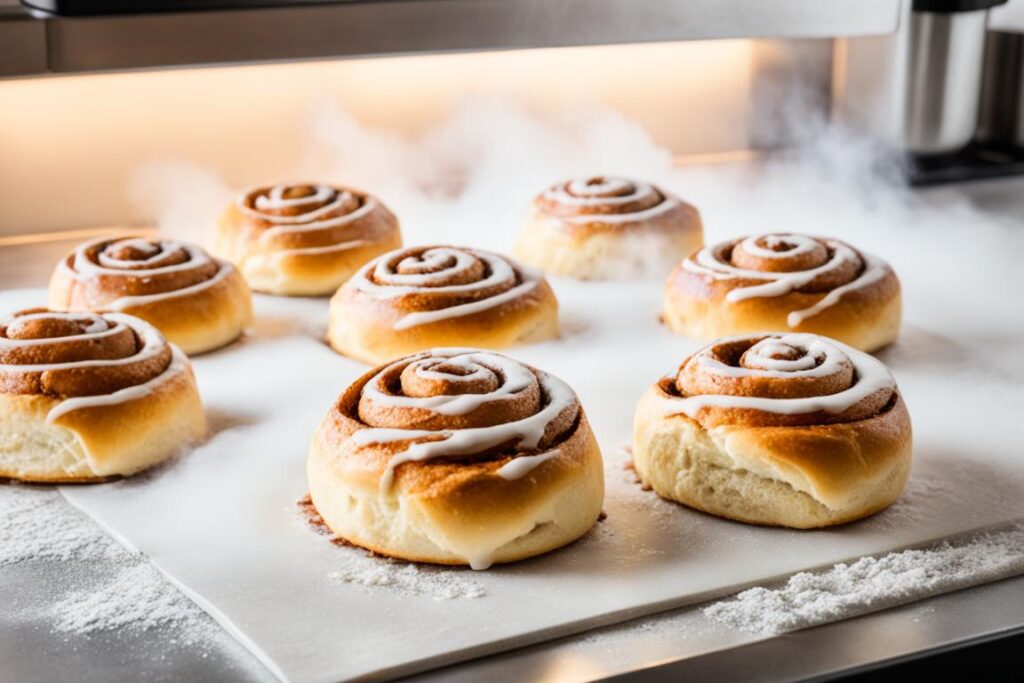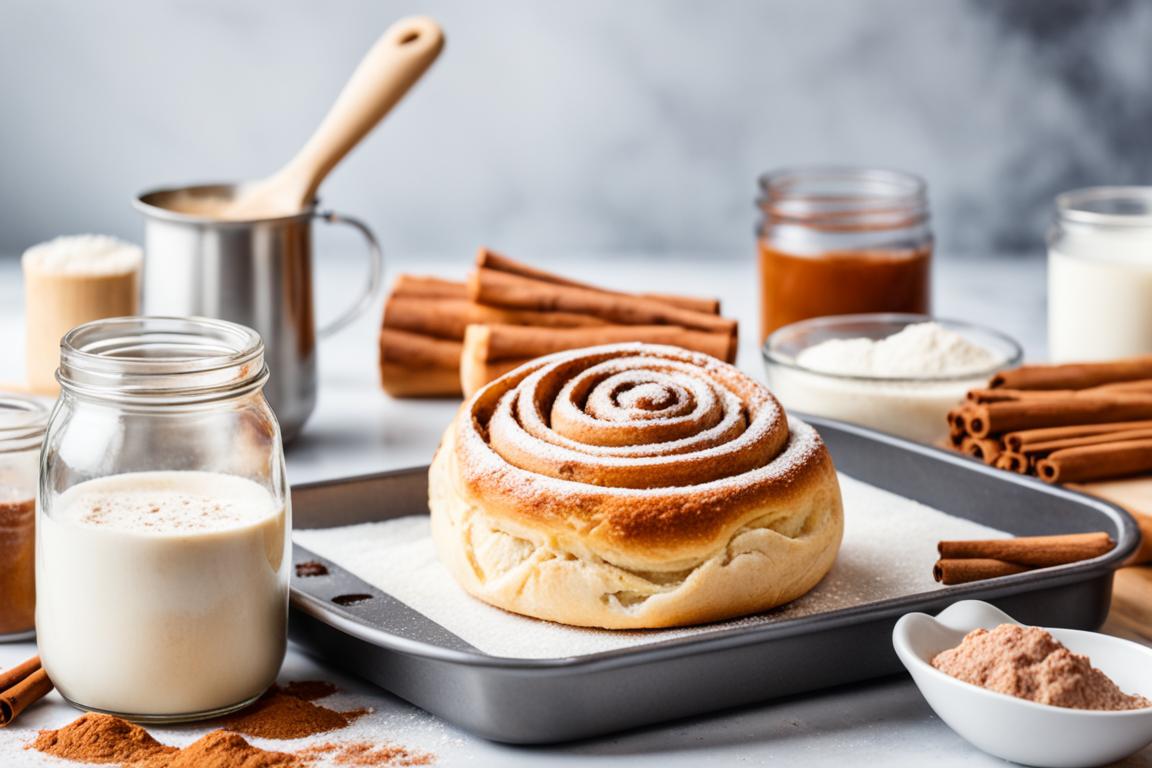Have you ever taken sourdough cinnamon rolls out of the oven, only to find they’re flat? It’s a big letdown, making you wonder: why didn’t my sourdough cinnamon rolls rise? Many bakers face this issue due to mistakes in sourdough fermentation, proofing time, and handling ingredients. Knowing what went wrong can help you make better rolls and improve your sourdough skills.
This article will look into key factors like the health of your sourdough starter, how temperature affects rising, and the importance of yeast activity. With the right info, fixing these baking problems is easier.
Key Takeaways
- Understand the importance of a healthy sourdough starter for proper rising.
- Explore how temperature affects fermentation and proofing time.
- Recognize the role of yeast quality and freshness in dough development.
- Learn about the effects of dough temperature on the final rise.
- Discover shaping techniques that can influence rise potential.
Understanding the Sourdough Rising Process
The sourdough rising process is a mix of art and science. It starts with fermentation, where wild yeast and bacteria work together. This process makes the dough rise and gives it a special taste.
Knowing the different stages of sourdough rising can improve your baking. The first stage, bulk fermentation, is key. It helps the dough get its structure and taste before shaping.
Then comes proofing, the last rise before baking. Each step affects how the dough rises and tastes.
Things like temperature and humidity matter a lot too. They change how fast the dough ferments and rises. Bakers should watch these things closely to get the right sourdough texture and taste.
One big challenge is getting the proofing right. Baking at the perfect time can fix this. Watching the dough closely helps bakers get better at making sourdough.
| Phase of Sourdough Rising | Description | Key Factors |
|---|---|---|
| Bulk Fermentation | The initial rise where flavors develop and dough strength increases. | Temperature, time, hydration level |
| Proofing | The final rise before baking, where dough is shaped and allowed to rest. | Time, humidity, dough shaping |
| Baking | Cooking the dough to create a crust and enhance flavor. | Oven temperature, steam, baking time |
Understanding sourdough rising helps bakers fix problems and get better at their craft. This makes baking more fun and rewarding.
Importance of Healthy Sourdough Starter
A healthy sourdough starter is key for getting your dough to rise well. How you prepare and handle it greatly affects your baked goods, like cinnamon rolls. Keeping the yeast alive and active is crucial for good fermentation. This makes your dough light and airy.
Keeping your starter healthy means feeding it regularly and storing it right. You can tell if your starter is doing well by looking for these signs:
- Consistent bubbling: This shows it’s fermenting actively.
- Spongy texture: A healthy starter feels light and fluffy.
- Pleasant aroma: It should smell slightly tangy, which means it’s fermenting well.
There’s a simple way to check if your starter is ready for baking. Just take a spoonful and drop it into water. If it floats, your yeast is active and you’re good to go.
If you ignore your starter, it won’t rise well, especially with things like cinnamon rolls. A well-cared-for starter is the base for the perfect rise and texture in any sourdough recipe.
Why did my sourdough cinnamon rolls not rise?
Understanding why sourdough cinnamon rolls don’t rise often starts with checking the starter’s strength. A strong sourdough starter is key for a great rise. To make sure the starter works well, you can do tests. These tests help bakers know if they need to make changes.
Testing Your Starter’s Strength
To check the starter’s strength, look for bubbling and see if it doubles in size after feeding. The float test is also a good way to get insights.
- Bubbling: A healthy starter bubbles a lot, showing it’s fermenting well.
- Doubling: A strong starter should grow about twice its size in a few hours after feeding.
- Float Test: If a spoonful of starter floats in water, it means it’s fermenting strongly.
Signs of a Healthy Starter
Knowing when a starter is healthy is key for baking great sourdough cinnamon rolls. Look for these signs:
- Aromatic profile: A nice, slightly tangy smell means it’s fermenting well.
- Texture: A healthy starter looks thick and has big bubbles.
- Regular feedings: Feeding it often keeps the starter strong.
If you don’t see these signs of a healthy starter, you might need to change how often you feed it or adjust the water levels. Fixing these issues helps get the dough to rise better.

Impact of Temperature on Dough Rising
The temperature of the dough is key to making great sourdough bread. It affects how the dough ferments, how long it rises, and its taste. Keeping the dough at 75-80°F is best for yeast activity.
Desired Dough Temperature (DDT)
Keeping the dough at the right temperature is crucial for quality sourdough. This temperature, or DDT, helps yeast work well. If the dough is too cold, it ferments too slowly, affecting rise and taste. But, if it’s too warm, it ferments too fast, leading to overproofing.
How Ambient Temperature Affects Rise Time
The temperature around the dough also matters. A cooler kitchen slows down the rise, while a warmer one speeds it up. Using tools like proofing boxes helps keep the temperature steady. This way, bakers can make their sourdough loaves consistently perfect.
| Ambient Temperature | Effect on Rise Time | Recommendations |
|---|---|---|
| Below 65°F | Slow rise | Use warm water or proof in a warmer location |
| 65°F – 75°F | Normal rise | Ideal for sourdough fermentation |
| 75°F – 85°F | Rapid rise | Monitor closely to avoid overproofing |
| Above 85°F | Very quick rise, risk of overproofing | Consider cooling methods to maintain dough quality |
Understanding how temperature affects yeast can improve your baking. For more tips on managing dough temperature, check out this resource.
The Role of Yeast Activity
Yeast is key to making sourdough bread rise. It turns dough into a light, airy treat. The yeast’s quality affects how well it ferments, making it important to start with good yeast. Using active yeast ensures your bread will rise well and look great.
Quality of Yeast Used
Choosing the right yeast is crucial. Fresh yeast, like Saf-Instant, is a top choice for its dependability. This type of yeast can quickly ferment sugars and produce carbon dioxide, making the dough rise. It also helps improve the flavor of the sourdough. Using active and fresh yeast helps avoid problems with the dough not rising.
Checking Yeast Freshness
It’s important to check if your yeast is fresh before baking. You can do this by mixing it with warm water. If it starts to foam after a few minutes, it means the yeast is good to go. But if it doesn’t foam, it might be old or not working right. Testing yeast regularly helps bakers avoid baking failures. Keeping yeast in a cool, dry place can also make it last longer.
| Yeast Type | Quality Indicator | Foaming Test | Recommended Use |
|---|---|---|---|
| Fresh Yeast | Highly active, typically sold in blocks | Foams vigorously within 5–10 minutes | Best for quick rises |
| Instant Yeast | Fine granules, easy to store | Foams within 10 minutes | Popular for most bread recipes |
| Active Dry Yeast | Needs rehydration before use | Foams within 5 minutes when rehydrated correctly | Common in home baking |
| Old Yeast | Expired or improperly stored | Does not foam | Best to discard |
Proofing Time: How Long Is Too Long?
Proofing time is key for perfect sourdough cinnamon rolls. The dough should double in size, showing it’s ready for the oven. Knowing the signs of dough readiness helps bakers check if the dough is proofed enough.
Proofing for too long can make the dough overproofed. This leads to flat, dense rolls. Look out for signs like losing volume, feeling sticky, or not keeping its shape. These are clues that the dough has overproofed.
In cooler places, dough takes longer to proof. Bakers need patience and watchful eyes. Changing proofing times with the room temperature can improve the rolls. Hurrying can ruin the quality of the cinnamon rolls.

| Proofing Condition | Time (Hours) | Signs of Dough Readiness | Signs of Overproofing |
|---|---|---|---|
| Warm Environment | 1-2 | Doubles in size | Collapse when poked |
| Room Temperature | 2-4 | Soft and airy texture | Very sticky and flat |
| Cool Environment | 4-6 | Holds its shape well | Diffused surface and excessive rise |
Dough Temperature: Finding the Sweet Spot
Getting the dough temperature right is key for great sourdough. The first temperature affects how well the dough rises. Mastering this can lead to amazing results.
Using Warm Water During Mixing
Warm water helps the dough get to the right temperature. It boosts yeast activity and makes fermentation faster. Make sure the water is warm but not too hot to soften the gluten right.
This makes the dough ready for rising. For more tips on sourdough rising, check out this resource.
Adjusting to Colder Environments
In cold places, you need special tricks to keep the dough warm. In winter or cool kitchens, use proofing boxes or warm water baths. This keeps the dough at the perfect temperature.
It helps the dough rise better and taste great. Knowing how to handle this is key for consistent baking.
Gluten Development and Its Importance
The secret to great sourdough cinnamon rolls is in the gluten development. This process makes the dough strong and gives it a good texture. It helps the dough rise by trapping gases during fermentation.
Kneading and folding the dough make it more elastic and strengthen the gluten. This creates a framework that helps the dough rise. It makes the rolls light and airy. The right amount of water is also key for a good gluten structure.
Getting the right balance of water and gluten is important. Too little water makes the dough stiff, and too much can make it weak. Finding the perfect mix makes the dough elastic and improves the rolls’ texture.
To make perfect cinnamon rolls, focus on developing the gluten during mixing and kneading. This helps the dough rise well. Bakers should aim for the right balance for a strong gluten structure and elastic dough.
| Aspect | Impact on Dough |
|---|---|
| Hydration Levels | Affects gluten strength; optimal hydration is crucial for rise |
| Kneading Techniques | Enhances dough elasticity and gluten development |
| Fermentation Time | Longer fermentation can improve gluten structure |
| Dough Temperature | Influences yeast activity and gluten dynamics |
The Effect of Roll Shaping on Rise
Roll shaping is key to getting sourdough cinnamon rolls to rise perfectly. Using the right dough shaping techniques helps the dough rise evenly in the oven. It’s important to shape gently and not press too hard. This prevents the dough from deflating and not rising well.
Trying out different shaping methods can lead to better results. This makes the cinnamon rolls look good and taste great. Bakers should try various techniques to see what works best with their dough. Rolling the dough tightly and keeping it in shape can greatly affect the final result.
Understanding how shaping affects the rise is crucial. Getting the cinnamon rolls just right isn’t just about the ingredients and temperature. It’s also about shaping them effectively. For more info on why sourdough rolls might not rise, check out this topic.


